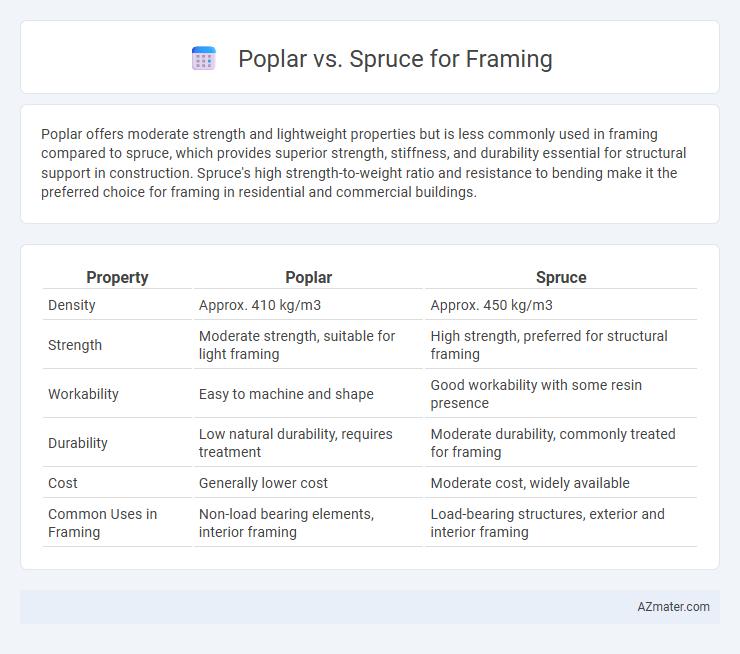Poplar offers moderate strength and lightweight properties but is less commonly used in framing compared to spruce, which provides superior strength, stiffness, and durability essential for structural support in construction. Spruce's high strength-to-weight ratio and resistance to bending make it the preferred choice for framing in residential and commercial buildings.
Table of Comparison
| Property | Poplar | Spruce |
|---|---|---|
| Density | Approx. 410 kg/m3 | Approx. 450 kg/m3 |
| Strength | Moderate strength, suitable for light framing | High strength, preferred for structural framing |
| Workability | Easy to machine and shape | Good workability with some resin presence |
| Durability | Low natural durability, requires treatment | Moderate durability, commonly treated for framing |
| Cost | Generally lower cost | Moderate cost, widely available |
| Common Uses in Framing | Non-load bearing elements, interior framing | Load-bearing structures, exterior and interior framing |
Introduction: Comparing Poplar and Spruce for Framing
Poplar and spruce are popular choices for framing due to their availability and workability, with spruce often favored for its strength-to-weight ratio and cost-effectiveness. Poplar offers a smoother finish and better resistance to splitting, making it suitable for detailed framing work where precision is essential. Understanding the differences in density, durability, and ease of handling between poplar and spruce helps builders select the optimal material for structural integrity and project requirements.
Wood Characteristics: Poplar vs Spruce
Poplar wood features a fine, even texture with moderate strength and excellent workability, making it suitable for interior framing where stability and ease of handling are prioritized. Spruce offers a higher strength-to-weight ratio and greater stiffness, commonly used in structural framing due to its superior load-bearing capacity and natural resistance to splitting. Both woods exhibit low to moderate durability, but spruce's superior strength and stiffness make it preferable for high-stress framing applications.
Strength and Durability Differences
Poplar wood offers moderate strength and is less dense, making it easier to work with but generally less durable than spruce in framing applications. Spruce provides higher strength-to-weight ratio and greater durability, which translates to better load-bearing capacity and resistance to wear over time. For structural framing where long-term stability and support are critical, spruce is typically preferred due to its superior strength and resilience.
Workability and Ease of Use
Poplar offers superior workability for framing due to its straight grain and softer texture, making it easier to cut, nail, and shape with standard tools compared to spruce. Spruce, while also lightweight and moderately workable, tends to have a tighter grain that can be more challenging to machine and may blunt tools faster. The ease of use in framing applications favors poplar for projects requiring precise cuts and smoother finishes.
Cost Comparison: Poplar vs Spruce
Poplar framing typically costs more per board foot than spruce due to its denser grain and smoother finish, making it a premium choice for projects requiring durability and aesthetic quality. Spruce offers a more budget-friendly option, with lower initial costs and widespread availability, which is ideal for large-scale framing where cost efficiency is critical. Comparing prices, spruce averages around $2 to $3 per board foot, whereas poplar can range from $3 to $5, reflecting the trade-off between cost and material characteristics in construction framing projects.
Availability and Sourcing
Poplar wood is more readily available in North America due to extensive plantations and sustainable harvesting practices, making it a cost-effective choice for framing projects. Spruce is commonly sourced from boreal forests across Canada and northern Europe, often resulting in regional availability fluctuations and higher transportation costs. Both woods are generally accessible through lumber suppliers, but poplar's faster growth rate and consistent supply give it an advantage in large-scale framing applications.
Poplar for Framing: Pros and Cons
Poplar wood offers a lightweight and cost-effective option for framing, with good workability and smooth finish, making it ideal for interior framing projects. Its moderate strength and ease of cutting or nailing contribute to faster construction, though it is less durable and more susceptible to moisture damage compared to spruce. While spruce remains a stronger choice for structural frames due to better load-bearing capacity, poplar excels in applications where weight and affordability are priorities without heavy structural demands.
Spruce for Framing: Pros and Cons
Spruce is a popular choice for framing due to its high strength-to-weight ratio, straight grain, and ease of cutting, making it ideal for structural applications where durability and stability are essential. It offers excellent load-bearing capacity and resistance to warping compared to poplar, which is softer and more prone to dents and deformities under stress. However, spruce may be more susceptible to moisture damage than treated or naturally durable species, requiring proper sealing and maintenance to ensure longevity in framing projects.
Best Applications for Each Wood Type
Poplar is best suited for interior framing applications where lightweight and ease of working with are priorities, such as non-load-bearing walls and decorative trim. Spruce, known for its superior strength-to-weight ratio and durability, is ideal for structural framing in residential and commercial construction, supporting load-bearing walls and roofing frameworks. Choosing spruce for these demands ensures better stability and resistance to bending compared to poplar.
Conclusion: Choosing the Right Wood for Your Framing Needs
Poplar offers a lightweight, easy-to-work-with option, making it ideal for interior framing projects where moderate strength and smooth finish are prioritized. Spruce provides superior strength and durability, making it the preferred choice for structural framing that requires robust support and resistance to stress. Selecting the right wood depends on balancing the framing project's load requirements with wood availability and budget considerations.

Infographic: Poplar vs Spruce for Framing
 azmater.com
azmater.com